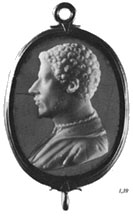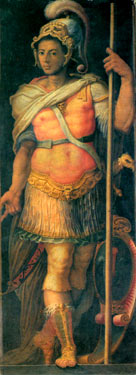

 |  |
| A cameo of Alessandro de' Medici by Domenico di Polo. | |
 |
In a current exhibition on Italian Renaissance art that is on display at the Philadelphia Museum until Feb. 13, 2005, a focal work is a portrait of Alessandro de' Medici. Unfortunately, however, the unique opportunity that this small, but important show might have offered to the national conversation on race has been ignored.
Down through the centuries, most scholars have accepted that Alessandro de' Medici's mother was a slave woman and she was so identified by Alessandro's contemporaries. But the subject of the African ancestry of Alessandro, the first Duke of Florence, is being downplayed by the curators of the Philadelphia exhibit, entitled "Pontormo, Bronzino and the Medici."
Due to a kind of snobbery endemic to the field - a subject which Phillipe de Montebello at the Met in New York so unabashedly has talked about - it is not just the Philadelphia Museum but the American art establishment in general that appears to be having difficulty coming to terms with this Medici scion from whom descends some of Europe's most titled families, including two branches of the Hapsburgs.
In just the last three years, for example, a portrait of Alessandro's daughter, Giulia, Princess of Ottojano, and another portrait of the Duke himself have appeared in two major exhibitions in the U.S.: one at the National Gallery in Washington in 2001 and another at the Art Institute of Chicago in an exhibit which a few months later travelled to the Detroit Institute of the Arts where it closed in 2003. However, as with the current Philadelphia exhibit, little was done by the curators of these shows to draw the public's attention to either the Duke's color or his place in history.
In the only reference to the Duke's color in the entire 173-page catalogue of the Philadelphia exhibit, Karl Strehlke, the curator and organizer writes, "Some scholars have claimed that Alessandro's mother was a North African slave. This cannot be confirmed, however, and the text of a letter that she wrote to her son in 1529 suggests that she was an Italian peasant from Lazio." Such a statement can only be described as disingenuous.
Based on what Lorenzino de' Medici, Alessandro's kinsman, wrote about her in his Aplogoia, all scholars who have dealt with the subject accept that the servant whom he cites as the Duke's mother, is one and the same Simunetta from Collavecchio in the province of Lazio. Besides her being specifically identified as a "slave" by the historians Bernardo Segni and Giovanni Cambi, both contemporaries of the Duke's, Cardinal Salviati, a relation of Alessandro's, describes this woman as "una villisima schiava." And, in point of fact, the question of identity that Lorenzino de' Medici does raise, and Segni repeats, is not whether Simunetta was Alessandro's mother, but whether the "mule driver" she subsequently married was Alessandro's father instead of one or the other of two candidates still attributed with his paternity.
As Christopher Hare in his work, Romance of a Medici Warrior, explains, "[Alessandro] was reported to be the son of the late Lorenzo dei Medici, Duke of Urbino, but the affection shown him by Clement VII, gave strength to the general opinion that the Pope was his father. In any case his mother was a mulatto slave, and Alessandro had the dark skin, thick lips and curly hair of a Negro."
Like Hare, one need only to browse through the images of the Duke published in Carla Langedijk's two-volume work, Portraits of the Medici, to verify contemporary descriptions of his apearance such as Ceccherelli's "capelli ricci neri e bruno in vise," (brown in complexion with very curly black hair) or Scipione Ammirato's "color bruno, labbri grossi e capegli crespi." (brown, thick lips and kinky hair.)
 |  |
| Girogio Vasari's full length portrait of Alessandro de' Medici from the frescos in the Palazzo Vecchio. |
 |
Granted, the majority of paintings, coins, medallions, etc. depicting Alessandro de' Medici were done after his assassination in 1537. However, they were the work of artists who had known him personally. The African traits of the Duke that appear in Giorgio Vasari's frescos in the Palazzo Vecchio, for example, are just as pronounced as in the more familiar image attributed to the school of Bronzino. Furthermore, in Vasari's own description of the work he did for this commission, the accuracy of the innumerable portraits he executed and the public's ability to identify them, especially after their demise, was the source of a great deal of pride for him.
But what could be more decisive proof of Alessandro's African ancestry than the following taken from Scipione Ammirato, the court historian of Alessandro de' Medici's successor, Cosimo:
"Non sono per tacere l'opinione,che in quel eta ando attorno intorno la nascita di Alessandro, la qual fu, che egli fusse nato d' una schiava in quel tempo, che il padre e i zij rientrarono in Firenze. Il che peravventura pote procedere per esser egli stato di color bruno, e per aver avuto i labbri grossi, e i capegli crespi."
What makes the omission of Alessandro's race in the current Philadelphia exhibition problematic, especially after criticism by the Washington Post and the New York Times for the similar omission in the National Gallery's exhibition, is the fact that besides being the first black head of state in modern western history, Alessandro de' Medici's race was quite pivotal to the Grand Ducal and the most politically powerful period of Medici history.
Pope Clement VII, Alessandro's father, who also was born illegitimate, obviously felt that his illegitimate son would need every political bootstrap he could obtain for him if Alessandro were to survive as the legal representative of the family. Hence the bargain Clement struck with the Emperor Charles V in 1529 to have Alessandro created Duke of Florence even though the family had assiduously avoided such honorifics so as not to appear insensitive to the republican aspirations of the population.
Considering not only the racial problems America is still struggling with but also the high proportion of African Americans in Philadelphia, the curators' treatment of the subject of Alessandro's African slave mother is troubling. All the more so considering how important a role the de' Medici have played in European history and culture and the implications this holds for undermining the racial preconceptions that people of color must still contend with today.
Moreover, it seems to me that in addition to the elitism of the rarified world of the art connoisseur, the old bugaboo of political correctness is also to blame. For those who push the victimization paradigm of the African American experience, there can be no room in the discourse on race for "narratives" that do not fit the stereotype.
But such a stance is misguided. A study of this particular branch of the Medici family would provide us with a unique and invaluable insight into how one of the most powerful and influential dynasties in Europe was forced to deal with the issue of race so early in the history of the African slave trade.
by Mario de Valdes y Cocom
|